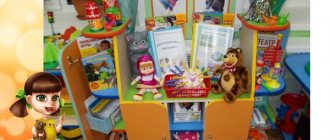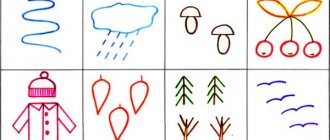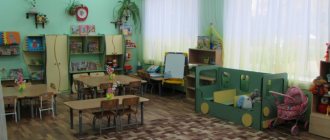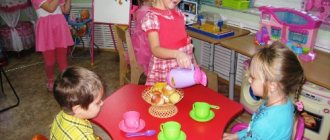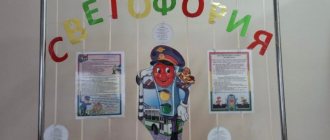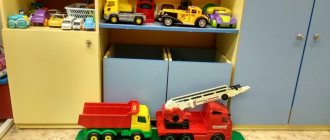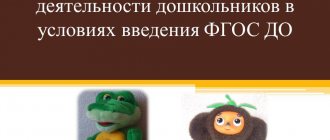Subject-based developmental environment as a means of developing oral speech in preschoolers.
Subject-based developmental environment as a means of developing oral speech in preschoolers.
The issue of organizing the subject-developmental environment of preschool educational institutions is particularly relevant today. This is due to the introduction of the new Federal State Educational Standard (FSES) to the structure of the basic general education program of preschool education.
In accordance with the Federal State Educational Standard, the program should be built taking into account the principle of integration of educational areas and in accordance with the age capabilities and characteristics of students. The solution of program educational tasks is provided not only in the joint activities of adults and children, but also in the independent activities of children, as well as during routine moments.
As you know, the main form of work with preschoolers and the leading activity for them is play. That is why practicing teachers are experiencing increased interest in updating the subject-development environment of preschool educational institutions.
The concept of a subject-developmental environment is defined as “a system of material objects of a child’s activity that functionally models the content of his spiritual and physical development”
(S.L. Novoselova).
Federal State Educational Standards requirements for a subject-development environment:
1. subject-development environment ensures maximum realization of educational potential.
2. accessibility of the environment, which implies:
2.1 accessibility for students to all premises of the organization where the educational process is carried out.
2.2. free access for pupils to games, toys, materials, aids, providing all basic activities.
The organization of the developmental environment in preschool educational institutions, taking into account the Federal State Educational Standard, is structured in such a way as to make it possible to most effectively develop the individuality of each child, taking into account his inclinations, interests, and level of activity.
It is necessary to enrich the environment with elements that stimulate the cognitive, emotional, and motor activity of children.
Good speech is the most important condition for the comprehensive development of children. The richer and more correct a child’s speech, the easier it is for him to express his thoughts, the wider his opportunities for understanding the surrounding reality, the more meaningful and fulfilling his relationships with peers and adults, the more active his mental development is. Therefore, we take care of the timely formation of children’s speech, its purity and correctness, preventing and correcting various violations, which are considered to be any deviations from the generally accepted forms of the Russian language.
Any speech disorder to one degree or another can affect the child’s activities and behavior. Children who speak poorly, beginning to realize their shortcomings, become silent, shy, and indecisive. Particularly important is the correct, clear pronunciation of sounds and words by children during the period of learning to read and write, since written speech is formed on the basis of oral speech and deficiencies in oral speech can lead to academic failure.
It has long been proven that the development of a preschool child is greatly influenced by the surrounding space and its occupancy. Teachers working with children with speech pathology have long come to the conclusion that speech corners should be in groups, should attract the attention of children, the desire to play, in this particular allocated space.
The speech development environment should contribute to the implementation of the following factors:
- perception of adult speech;
- observation of language;
— involvement in an active speech environment;
- dialogue between adults.
A speech development environment is a specially organized environment that most effectively influences the development of various aspects of each child’s speech.
The goal of building a speech development environment is to saturate the environment with components that ensure the development of speech in a preschool child.
Objectives of building a speech development environment:
— ensuring the possibility of perception and observation of correct speech;
- ensuring a richness of sensory representations;
— ensuring the possibility of independent individual speech activity of the child;
— ensuring the child’s comfortable state in the manifestation of speech reactions;
— providing opportunities for research and experimentation in the language system.
Components of the SRS (speech development environment): teacher speech, methods and techniques, equipment.
The content of the speech development environment is determined by the priority line of speech development of children of each age.
RRS 2nd junior group:
• Competent, pedagogically appropriate speech of the teacher;
• Methods and techniques aimed at developing speech as a means of communication (instructions, hints, sample appeal, sample interaction through speech in different types of activities);
• Methods and techniques aimed at developing the ability to listen and hear (conversations, reading, stories);
• Organizing a “corner of interesting things” (stimulating independent viewing of pictures, toys, books, objects for the development of proactive speech, enriching and clarifying children’s ideas about the environment).
RRS middle group:
• (satisfying the need to receive and discuss information, developing communication skills with peers, becoming familiar with the formulas of speech etiquette);
• listening to children, clarifying answers, giving hints, telling stories from the teacher - emphasis on stimulating cognitive interest);
• speech corner (sets of pictures, photographs, postcards, magnifying glasses, magnets, etc. for the development of explanatory speech).
RRS senior and preparatory groups
:
• (familiarity with the formulas of speech etiquette, targeted formation of all groups of dialogical skills, skills of competently defending one’s point of view);
(encouraging children's stories, transforming statements into coherent stories, recording and repeating stories, clarifications, generalizations);
• (replenishment of the corner - emphasis on expanding children’s ideas about the diversity of the world around them, organizing perception with subsequent discussion).
• Creation of an individual “author’s speech space” for each child.
When organizing a speech center, the following requirements must be met:
A necessary attribute of the speech corner is a mirror (individual mirrors, gaming, didactic, visual material.
Didactic equipment must correspond to the structure of children’s speech disorders, their individual and age characteristics.
Visual, didactic material in the speech corner changes according to the lexical topic.
It is advisable to place the speech corner next to the book corner.
The design of the corner should be aesthetic, attractive to children, and evoke a desire for independent activity.
Game material must be accessible to the child.
Do not overload the corner with equipment.
An integral attribute of the speech corner should be a toy - an “animate character”, which helps solve such important correctional problems as overcoming uncertainty, shyness, achieving emotional stability, self-regulation, arousing speech interest in children, and encouraging speech activity.
The speech development zone should correspond to the general design of the group.
You can come up with a name for it, for example, “Learning to speak correctly,” or simply allocate a place. In its design, it is necessary to show individuality and creativity so that children would like to use the materials and aids presented. For example, her hero could be a kind gnome who will teach how to speak correctly, or a doll with a large tongue who will show articulatory gymnastics, and vice versa, a foreigner or extraterrestrial, whom children will teach to speak beautifully in Russian.
The content of the speech corner should reflect all areas of work on speech development:
— development of the child’s vocabulary
- work on the grammatical structure of speech (teaching various methods of word formation, forming grammatically correct speech)
- development of coherent speech (composing descriptive and creative stories, retellings, describing pictures and objects, working with riddles, proverbs and sayings, poems)
- education of the sound culture of speech (improvement of diaphragmatic speech breathing, development of auditory attention and phonemic hearing, consolidation of pure sound pronunciation in speech,)
- preparation for learning and literacy training (familiarity with sound-letter analysis and synthesis, dividing words into syllables, sentence analysis)
– development of fine motor skills and graphomotor function
— acquaintance with fiction (can be separated into a separate book corner)
Equipment and filling of the speech zone:
1. Strengthening correct speech exhalation
"Leaves"; "Butterflies"; "Magic fluff"; labyrinths; multi-colored balls; sultans; paper snowflakes; pinwheels - pencils; foil bells on a string “Storm in a glass”; “Whose boat will get there faster”; “Put the ball into the goal”, etc.
2. Formation of phonemic perception and hearing
Noise instruments; sound boxes; children's musical instruments: piano, accordion, drums, pipe, tambourine, rattle, bells, rattles; subject, plot pictures for expressing sounds and their automation; games with paired cards (sounds: R, L; S, 3, C; Sh, Zh, Shch); sounds of vowels and consonants (houses for hard and soft sounds, pictures “stone”, “cotton wool”); individual aids for sound-letter analysis; word schemes; sound tracks, sound ladder; albums on the syllabic structure of the word “Collect a bouquet”; “We divide words into syllables”; "Find yourself a partner"; “Find what sounds”; “Guess where the sound is coming from”; “Lay out the pictures”; “Repeat - don’t make a mistake”; "Quiet - loud"; "General sound"; “Come up with words with sound”; "Broken phone"; “Sound symbols”, etc.
3. Development of articulatory motor skills
Subject pictures-supports; articulatory structures of the scheme; articulatory gymnastics in albums for a specific sound; diagram of the characteristics of sound articulation; articulatory gymnastics in poetry and pictures; forms of articulatory gymnastics for lips and tongue in symbols; albums with articulatory gymnastics; diagram for characterizing sound.
4. Consolidating the skills of correct sound pronunciation of given sounds (in isolation, in syllables, words, in sentences, in coherent speech).
Small toys; subject pictures; story pictures; various types of theaters; albums for every sound; speech therapy albums for automating various sounds, tongue twisters, poems, nursery rhymes, tongue twisters; sound characteristics diagram; word scheme; mirrors in the Lotto assortment for sounds C, 3; F, W; R, L; “Speech therapy lotto”; "Fun Gymnastics"; “Sounds, I distinguish you (R, L)”
5. Reinforce skills learned in literacy classes
Magnetic board; sets of magnetic letters; boxes of letters and syllables; symbols for sound-letter analysis, cubes “ABC in pictures”, “Learn to read”, “Smart cubes”, “Syllable cubes”, etc.; album “Learning Letters”; manual “Talking ABC”; magic house “ABC book” by N. S. Zhukov, “Reading by syllables”, “Reading with hints”; "Texts with tails"; baby books, etc. “Name, read, check”; "Learn to read"; “I am learning letters”; "Find the letter"; “Are you ready for school? "; "Syllable Lotto"; "Magic Braid"; “Find the place of the sound in the word”; “Read by first sounds”; “Syllabic piggy bank”, etc.; "Smart Games" series, puzzles.
6. Activation of vocabulary, generalizing concepts and lexico-grammatical categories
Subject pictures on lexical topics; “Big and small” (used in a diminutive form) “What is made of what”; "Weather forecast"; "Dress the doll"; "In the animal world"; "Children's computer" and others.
7. Development of coherent speech
Series of plot pictures “Stories in Pictures”; different types of theater; pure sayings, poems, nursery rhymes, tongue twisters; library of children's books, etc.
8. Development of fine motor skills
Dry pool; massage rollers, balls, clothespins, stencils; finger games (memo diagrams on lexical topics); “The world of your fantasies” (various materials for composing letters) Hatching games; “Drawing by cells”; mosaics; lacing games, etc.
Conclusion
The development of cognitive and speech abilities in children is one of the main tasks of preschool education. One of the most important cognitive processes of a person is speech. Solving these problems is impossible without creating a modern subject-development environment. The organization of a “Subject Developmental Environment” in a kindergarten brings the effectiveness of educational influence aimed at developing in children an active cognitive attitude towards the surrounding world of objects, people, and nature. Teachers should pay special attention to the subject environment, especially its developmental nature. One of the main tasks is to enrich the environment with elements that would stimulate cognitive, speech, motor and other activity of children.
I wish everyone good luck in their work!
4
MAGAZINE Preschooler.RF
Consultation for teachers. Topic: Developing subject-spatial environment - as the most important factor in the development of speech in preschool children. “A child will not speak in empty walls”Elizaveta Ivanovna Tikheyeva, famous Russian and Soviet teacher.
One of the main organizational and pedagogical conditions and methods of speech development of preschool children is:
creation of a high-quality, rich spatial subject-development environment in a preschool educational institution, which should satisfy the important life needs of a preschooler in cognition and communication.
A speech development environment is a specially organized environment that most effectively influences the development of various aspects of each child’s speech.
The educational field “SPEECH DEVELOPMENT” includes:
- mastery of speech as a means of communication and culture;
- enrichment of the active vocabulary; development of coherent, grammatically correct dialogical and monologue speech;
- development of speech creativity; development of sound and intonation culture of speech, phonemic hearing;
- acquaintance with book culture, children's literature, listening comprehension of texts of various genres of children's literature;
- formation of sound analytical-synthetic activity as a prerequisite for learning to read and write.
Main goals and objectives of the educational field
Speech development:
Speech development.
- Developing free communication with adults and children, mastering constructive ways and means of interaction with others.
- Development of all components of children's oral speech:
- grammatical structure of speech
- coherent speech - dialogical and monologue forms
- formation of a dictionary
- education of sound culture of speech.
3. Practical mastery of speech norms by students.
Fiction.
Cultivating interest and love for reading; development of literary speech.
Cultivating the desire and ability to listen to works of art and follow the development of the action.
The goal of building a speech environment is to saturate the environment with components that ensure the development of speech in a preschool child.
Tasks of constructing a speech environment:
- providing the opportunity to perceive and observe correct speech
- providing rich sensory representations
- ensuring the possibility of independent individual speech activity of the child
- ensuring the child’s comfort in the manifestation of speech reactions
— providing opportunities for research and experimentation in the language system.
To develop the speech of preschoolers, it is necessary to organize centers that stimulate children's speech activity.
In order to create an effective developmental subject-spatial environment in a preschool institution, speech activity centers have been established in all age groups, which
provides a specific list of materials and equipment.
Normative - symbolic material that prepares the child for mastering written language (reading and writing):
various sets of letters, devices for working with them, alphabet tables, etc.
Figurative and symbolic material: specially designed, so-called “visual aids” :
subject and subject paintings, illustrations, series of pictures with plot development of the plot;
algorithms for teaching storytelling and description; mnemonic tables for memorizing poetry
A variety of practical material for organizing speech games and activities.
Types of card files of games and exercises for equipping the speech corner:
- Card file of articulation exercises + set of mirrors (with handle).
- Card file of breathing exercises.
- Card index of finger games.
- Card index of wellness breaks with poetic text
- Didactic games to enrich vocabulary.
- Didactic games for the development of GSR.
- Didactic games for the development of SR.
- Didactic games to improve the ZKR,
phonemic perception.
When organizing a speech center, the following requirements must be met:
- Visual and didactic material in the speech corner changes according to the lexical topic.
- It is advisable to place the speech corner next to the book corner. The design of the corner should evoke a desire for independent activity.
- An integral attribute of the speech corner should be a toy - an “animate” character that helps to arouse children’s speech interest and encourage speech activity.
- Game, didactic and visual material must correspond to the age of the children in the group.
- A necessary attribute is a mirror.
Criteria for equipping a spatial subject-development environment:
- corner filling
- variety of material
- age appropriate
- availability
- consistency
- design aesthetics
- leading toy ( "mistress" of the speech corner).
Contents of speech corners in preschool groups.
Second early age group
— Didactic games in the areas of speech development for children of this age
— Articulation, breathing and finger exercises
-Pictures on lexical topics.
-Art works according to the program.
-Subject pictures:
- with images of toys, personal hygiene items; clothing, shoes, dishes, furniture, bedding, vehicles, vegetables, fruits, domestic animals and their babies
- showing the size, color of items, taste, temperature of items (red, big, hot, sweet, etc.)
- depicting actions (going to bed, sitting down, getting dressed, walking, sweeping, etc.).
Second junior group
— Didactic games in the areas of speech development for children of this age
— Articulation, breathing and finger exercises
-Pictures on lexical topics.
-Art works according to the program.
-Subject and subject pictures:
-items of clothing, shoes, hats, dishes, furniture, types of transport, parts of the day, domestic animals and their babies, vegetables, fruits, etc.
- with an image of the location of objects (outside the window, high, far, under the closet).
-with images of some materials and their properties (for example: paper is smooth, it breaks)
-with the image of actions.
Middle group
— Didactic games in the areas of speech development for children of this age
— Articulation, breathing and finger exercises
-Pictures on lexical topics.
-Art works according to the program.
-Algorithm for compiling descriptions and comparisons of objects.
-Subject and subject pictures:
- depicting familiar fairy tales (telling based on a plot picture)
- depicting objects, phenomena, events that did not take place in their own experience
- with an image of the location of objects (outside the window, high, far, under the closet).
- with the image of opposite objects (antonyms)
- depicting professions and their work activities.
Senior group
— Didactic games in the areas of speech development for children of this age
— Articulation, breathing and finger exercises
-Pictures on lexical topics.
-Art works according to the program.
-Algorithm for compiling a description and comparison of objects, objects, phenomena (mnemonic tables).
-Subject and subject pictures:
- depicting folk crafts, mini-collections (postcards, stamps, coins, sets of toys made from a certain material), illustrated books (including familiar fairy tales with drawings by different artists), postcards, photographs
with the sights of your native land,
- with a plot (consistently developing) action.
Preparatory group
— Didactic games in the areas of speech development for children of this age
— Articulation, breathing and finger exercises
-Pictures on lexical topics.
-Art works according to the program.
-Algorithm for compiling a description and comparison of objects, objects, phenomena (mnemonic tables).
-Subject and subject pictures:
- to enrich children’s everyday, natural history, and social science vocabulary.
-Graphic image:
- composing a sentence using a given number of words
- dividing a sentence into words (excluding prepositions and conjunctions)
-dividing a word into syllables (two-syllable and three-syllable with open.
Important to remember:
- The development of fine movements of the fingers is especially closely related to the development of speech. According to the famous philosopher Kant, “the hand is the human brain moving forward.” It is necessary to use exercises for the development of fine motor skills, so-called finger gymnastics, as often as possible in educational activities and games with children.
- It is important to use motor-speech means. They are often used for dynamic pauses, for automating sounds, and for developing skills to coordinate movements with speech. Poems are selected to match the rhythm of the poetic line with the movements of the arms, legs, and torso. The length of the line must be average in order to select the appropriate movement for it
- Speech corners should attract children's attention and desire to play in this designated space.
- It is necessary to take care of the timely formation of children’s speech, its purity and correctness, preventing and correcting various violations
- Competent, pedagogically appropriate speech by a teacher is an important component of children’s speech development.
Teacher of the highest category Borisova Marina Aleksandrovna
MBDOU kindergarten No. 3 “Fairy Tale”, Knyaginino, Nizhny Novgorod region
| Next > |
Good speech is the most important condition for the comprehensive development of children. The richer and more correct a child’s speech, the easier it is for him to express his thoughts, the wider his ability to understand the surrounding reality. A child is not born with developed speech; it is impossible to say unambiguously when and how the baby masters the ability to speak, pronounce sounds correctly and clearly, connect words with each other, construct sentences of varying complexity, and express his thoughts coherently and consistently. The formation of a holistic picture of the world and broadening of horizons is greatly influenced by the organization of a subject-spatial developmental environment, that is, it is necessary to create conditions for independent speech activity of preschoolers. To solve this issue, a developmental subject-spatial environment was created in all groups, which included material objects of the child’s activity and the ability to functionally model the content of his comprehensive development. The developing subject-spatial environment is organized in accordance with the requirements of the approximate basic educational program of preschool education, edited by N.E. Veraksy, M.A. Vasilyeva, T.S. Komarova “From birth to school”, developed on the basis of Federal State Educational Standards. According to the Federal State Educational Standard for Educational Education, the developing subject-spatial environment must be content-rich, multifunctional, transformable, accessible, variable, and safe. When creating a speech development environment, the following are taken into account: - the characteristics of children of a particular age group - the level of speech development of each child - the interests and abilities of children “A child will not speak in empty walls” Elena Ivanovna Tikheyeva. By saturating the group space, our teachers primarily ensure that children in the group can satisfy their important life needs in movement, cognition, and communication with adults and peers. Kindergarten groups are equipped with gaming and teaching equipment, which includes visual and handout material. In order to create conditions for stimulating speech activity and verbal communication, speech development centers have been established in our kindergarten in all age groups. Teachers have accumulated and systematized a variety of practical material for organizing speech games and activities. They include manuals for articulation exercises, materials for storytelling, a variety of didactic, board and printed games, games for the development of fine motor skills, sets of finger games, toys for the development of correct speech exhalation, thematic albums, games for enriching vocabulary, formation grammatical structure, coherent speech, development of phonemic hearing and fine motor skills and much more. In free play activities, children independently practice in the center: do tongue exercises, play games to develop air flow, take outlines, lacing, mosaics, and puzzles. One of the forms of work on speech development is a lapbook. A laptop is an interactive folder that allows you to replenish children's vocabulary, speed up and make more attractive the process of automation and differentiation of sounds, form grammatical categories, develop coherent speech, and improve fine motor skills. At any convenient time, the child opens the laptop and happily repeats what he has learned. An interesting material for children in the speech corner is the game guide “Speech Cube”. The manual consists of cubes of different sizes made of cardboard. On each side of the cube there are transparent pockets designed for replaceable speech material. This material is used when performing articulation exercises to develop children's gross and fine motor skills, lexical and grammatical structure and coherent speech. It is changed by the teacher as the children master various topics. Children play with cubes independently in their free time, reinforcing the material worked out in class. While playing, preschoolers toss the cube and complete the task that lands on the side of the cube. The content and updating of material in the corner occurs periodically and depends on the topic of the week, month, lexical topic, traditions and holidays, which corresponds to the principle of transformability and variability of the subject-spatial environment. According to the principle of multifunctionality, other components of the group’s subject environment are used in the corner, such as: a screen for showing puppet shows, soft portable modules, a magnetic board. All materials in the corner are freely available to children and provide all the main types of children's activity: gaming, cognitive, creative, motor, communicative), which corresponds to the principle of accessibility. The principle of safety is implemented in the reliable strengthening of all equipment in the corner and the safety of the materials from which the games and aids are made, as well as the safety of their use. Properly selected books have a great influence on the development of speech. Children look at illustrations of familiar and unfamiliar works of art. Turning to familiar works strengthens children's memory, telling stories using pictures and illustrations, and develops and enriches speech. Here are your favorite children's fairy tales and stories on lexical topics, as well as illustrative material and photographs of children's writers. Together with the children, we systematically organize exhibitions of the works of this or that author (for example, for anniversaries), conduct literary quizzes and reading competitions. Along with fiction, the book corner presents reference and educational literature. Each child can independently choose a book, pictures, illustrations as they wish. To develop speech creativity in all age groups, corners of theatrical games have been organized, where various types of theater are located. Here the child can independently or with the participation of an adult take on the role of a fairy-tale character. We also use a theater on a flannelgraph, a theater on a magnet, which is designed specifically for children not only to listen to a fairy tale, but also to see its characters. Together with the music director, we stage puppet theater shows with children and show them to younger children. We also stage theatrical productions of fairy tales for children’s matinees and events with parents. Role-playing games (“Hospital”, “Family”, “Shop”, “Hairdresser”, “Young Master”, etc.) are of great importance for the development of a preschooler’s speech, which contribute to the development of children’s role-playing speech and the ability to conduct a dialogue with peers and adults, so in each group all the necessary conditions have been created for such games. In order to develop the creative potential of teachers, our preschool educational institution holds review competitions for the best design of the subject-spatial environment. We visit the children's library with the children of the senior and preparatory groups. After such excursions, children begin to visit with pleasure with their parents and become young readers. The help of parents plays an important role in organizing the subject-spatial environment. They made various types of theaters: knitted, spoon theater, finger theater, caps and masks for theatrical performance, material for the development of fine motor skills (massage balls, clothespins). The inclusion of parents in the pedagogical process is also the most important condition for the full speech development of the child. Working on the problem of children's speech development for parents: • Information stands are set up in preschool groups. • Consultations and individual conversations are conducted with a speech therapist teacher on the topics: “How to develop coherent speech”, “Learning poetry”, “Child and book”, “The role of the family in raising children’s speech”, “Developing speech by playing”, etc. . • A master class was held on the joint production of games and aids for the formation of the grammatical structure of speech, “Didactic games and aids that develop phonemic perception.” • Master classes “Use of mnemonics in the development of children’s speech”, “Playing with fingers - developing speech”. In order to develop the creative potential of teachers, our preschool educational institution holds review competitions for the best design of the subject-spatial environment. The child’s verbal interaction with objects of the developmental environment and with peers contributes to the development of his experience of verbal communication, the development of independence, initiative in establishing verbal contact, and the free choice of the subject of communication. The number of speech contacts between peers, which arise spontaneously, on the initiative of the children themselves, is increasing. As the practice of working in kindergarten shows, a properly organized developmental environment allows a child to learn to interact with peers and adults, to understand and evaluate the feelings and actions of people, and this is precisely what underlies developmental communication.
